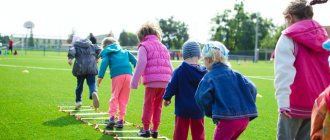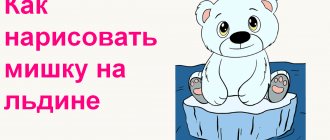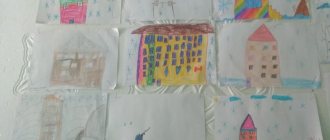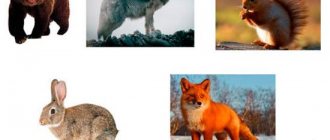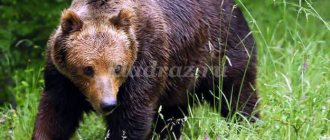Lesson notes for the senior group. Animal world
Summary of the lesson “Animal World” for children of the senior group
Author: Slobodskaya Angela Olegovna. Objectives: 1. Expand knowledge about domestic and wild animals. 2. Distinguish between different animals according to their characteristic features, continue to familiarize children with the classification of animals (wild, domestic). 3. Name baby animals. 4. Develop emotional responsiveness, aesthetic perception of the surrounding world, and form an ecological culture. 5. Foster a caring attitude towards living nature. Develop aesthetic perception. Preliminary work: looking at illustrations, books, drawing and sculpting animals, reading books, memorizing poems, guessing riddles.
Progress of the lesson:
There is a recording of the voices of domestic animals (cows, horses, pigs, goats) - which animals’ voices do you recognize?
(children's answers). - What are these animals called in one word? (children's answers). The teacher asks you to remember what other pets there are? (children's answers). Why are they called pets? (children's answers). What benefits do they bring? (children's answers). There is a recording of the voices of wild animals (bear, wolf, hare) - what animal voices do you recognize? (children's answers). - What are these animals called in one word? (children's answers). Why are they called wild? (children's answers). — Tell me, what are the characteristics of animals? (they have paws, a tail, a muzzle, fur) The teacher suggests a musical break. Song "Zverobika". The cat sat down on the window and began to wash her ears with her paw. After watching her a little, we can repeat her movement. Chorus: One, two, three, come on, repeat, Three, four, five - repeat again. One, two, three, come on, repeat, Three, four, five, repeat again. Very good. A snake crawls along a forest path, like a ribbon slides along the ground. And we can depict this movement for you with our hands. Chorus:
stands all day in the swamp And catches frogs with its beak.
It’s not at all difficult to stand like that for us, for trained guys. Chorus:
The monkey came down from the branch to us, The monkey must be respected.
After all, monkeys are our ancestors, and children, we must imitate our ancestors. Chorus:
There are a lot of monkeys, cats and animals in the world, But, man, you are a friend of nature And you must know the habits of all animals.
Chorus
- And now I’ll tell you riddles, if the answer is correct, then a card with a picture of this animal will be posted.
Riddles: 1. Shaggy, mustachioed, drinks milk, sings songs. (cat) 2. She doesn’t speak, doesn’t sing, but who goes to the owner, She lets him know. (dog) 3. In front there is a snout, in the back there is a hook, in the middle there is a back, on the back there is a bristle. (pig) 4. Neither the lamb nor the cat Wears a fur coat all year round. The fur coat is gray for summer, for winter - a different color. (hare) 5. Like a Christmas tree, covered in needles. (hedgehog) 6. Fluffy tail, golden fur lives in the forest, steals chickens in the village. (fox) 7. Who wanders around in the cold winter, angry and hungry. (wolf) 8. The owner of the forest, wakes up in the spring, And in winter, to the howl of a blizzard, Sleeps in a snowy hut. (bear) 9. He’s waiting for me on the road. He beats his hoof at the gate. His mane plays in the wind. Lush, fabulously beautiful. I’ll quickly jump onto the saddle and fly clop-clop-clop. (horse) 10. She is big, with horns and hooves on her legs. The tail is like a panicle. It eats hay and gives milk. (cow) - Guys, let's count how many pets there are? Count it. (Children count at the blackboard). Game "Name the Cubs" . (One-many) Game “Who lives where? " (Figures of domestic and wild animals are laid out on the table. 2 children are called. One child will put the wild animals in the forest, and the other child - in the hut). The teacher uses a “magic” wand to transform children into forest dwellers. “And now you and I will close our eyes and turn into forest dwellers.” Physical education One-squat, two-jump This is a rabbit exercise, And when the foxes wake up, they like to stretch for a long time. Be sure to yawn and wag your tail. And the wolf cub arches its back, And jumps lightly, The cub bear, with his paws spread wide, First one, then both together, Marks time for a long time. And for those who don’t have enough exercise, it starts all over again. - Fine! And now I again turn you into our obedient children (close our eyes). Working at a desk. Give the children sheets of paper and pens. — Guys, let’s listen to the task: “Animals (wild and domestic) are drawn here.” Wild animals need to be circled, and domestic animals need to be led to the barn (hut) with an arrow.” The children do the work. The teacher walks among the children and watches how they complete the task. (Calm music sounds). Educator : Thank you guys, it’s very interesting and fun to be with you. Now, tell me, what would happen if all the animals on earth disappeared? Summarizing the children's answers, the teacher talks about the need for all animals in nature. Educator: And now our children will read B. Zakhoder’s poem “Everyone in the World is Needed.” Summary of the lesson: “What animals did we talk about? (Children's answers). Today you all tried very hard and answered well. Well done! Let's say "Thank you" to each other!
We recommend watching:
Summary of educational activities in the senior group “Journey to a Fairy Tale” Summary of a mathematics lesson for children of the senior orthopedic group Summary of educational and gaming activities in the senior group in the section of the “Childhood” program Thematic day in kindergarten “Animal Day”
Similar articles:
Lesson in the senior group of kindergarten on the topic of February 23
Lesson notes for children of senior preschool age. Topic: Invisible air
Summary of organized educational activities for children of the senior group
Notes for mathematics classes in the senior group
Lesson summary on the topic “Reserve” in the senior group
Lesson summary on the surrounding world on the topic: “The diverse world of animals.”
Lesson summary on the world around us, grade 2
Lesson topic:
"The diverse world of animals."
Lesson type:
discovery of new knowledge
Goal
: to form children’s understanding of groups of animals and their distinctive features.
Objectives:
1. Consider the dependence of the structure of animals on their lifestyle; 2. Introduce interesting facts from the life of animals.
Planned results
(subject): they will learn to classify animals according to their distinctive features, will have the opportunity to learn how to establish a connection between the structure of the body and the way of life of the animal, and extract the necessary information from the textbook.
Universal learning activities
(metasubject):
Regulatory:
be able to independently plan and carry out your actions using familiar educational material, evaluate the correctness of the actions; adequately perceive the assessment of the teacher and classmates with feedback on the work performed; be able to evaluate the results of your work in the classroom.
Communicative:
be able to convey your position to others, be able to reason and analyze; work in a group and evaluate your friend.
Cognitive:
search for the necessary information to complete educational tasks, use sign-symbolic means (schemes), be able to analyze objects highlighting essential and non-essential features.
Personal:
show cognitive interest, dedication and perseverance in achieving the goal, jointly agree on the rules of communication in the group.
Equipment for the lesson
: presentation “What kinds of animals are there?”, textbook for grade 2 “The world around us” by A.A. Pleshakova.
During the classes
- Organizing time.
-Let's smile at each other.
It's good when the day starts with a smile. Try to maintain this good mood throughout the lesson. 2. Checking homework.
-Today we will continue our journey, but where?
You will find out by solving the riddle: The house is open on all sides, It is covered with a carved roof. Come into the green house, you will see miracles in it. - What is this riddle about? (forest) -Why is the forest called the “lungs” of the planet? (The forest is a factory for the release of oxygen; it is necessary for the life of all living things) - What three tiers does the forest consist of? (Trees, shrubs, herbs) 3. Report the topic of the lesson.
— In the forest we can see not only plants, but also someone else. - Now you have to solve riddles. 1. Even the cat runs from him, he flies and buzzes. This sound is familiar to everyone - That green, May... BEETLE 2. Gets into the habit of getting into the poultry house - expect trouble. Covers his tracks with his red tail. FOX
3. In winter he sleeps, in summer he stirs up the hives. BEAR
4. At the bottom, where it is quiet and dark, lies a mustachioed log. COM
5. She walks in the rain, loves to pluck grass, quacks, it’s all a joke, of course it’s a DUCK
6. And in the green grass, quietly, dashingly galloping along the blades of grass, all in green, a nimble little... GRASSHOPPER
7. Lives in a mink, chews crusts; Short legs; afraid of cats. MOUSE
8. Driven by a whip, Rushes in a harness, then nibbles the grass all day long A slender northern... DEER
- How can we call them in one word? (Animals) - What do you think we will talk about in class? (About animals). The topic of our lesson. What kinds of animals are there? -Are all animals the same? (Children's answers) -What goal will we set for ourselves? (Distribute animals into groups based on their distinctive characteristics.) — Today we need to answer what questions?
- What kinds of animals are there? Identify the distinctive features of each group of animals
. 2. Find information that is new to us.
4. Solving an educational problem and discussing a project for its solution.
Let's start implementing the first point of our plan 1. Let's find out what groups animals can be divided into. Let's learn to identify and compare the characteristics of groups of animals.
The words are written on the board; you need to find the extra word in the row - perch, pike , frog
, crucian carp;
– grasshopper, butterfly, turtle
, beetle;
- bear, fox, toad
, hare;
- sparrow, dove, snake,
woodpecker.
Name who you chose. -What is the body covered with? Where live? “Fish”
There are so many fish!
Thin and long, like a whip, round, like a ball, tiny - the size of an ant and huge - larger than an elephant. Fish scales grow throughout their lives, growing in rings. In summer, the fish grows quickly - and the ring on the scales is wide, but in winter it hardly grows - and the ring turns out to be narrow. By the rings, wide and narrow, you can count how many winters the fish has had and how old it is. - insects - How many legs? What size? “Insects”
Next to us lives a world of creatures that are so little similar to us in their structure and way of life that they can easily be mistaken for inhabitants of another planet.
These amazing creatures are insects. We have four limbs - they have six. We have two eyes, and many of them have three more small eyes on their foreheads. We have a hearing organ - ears - on our heads, but in insects it can be anywhere: in grasshoppers, for example, in the leg. -What insects of the Nikolsky district do you know? - animals - How many legs? What is the body covered with? “Beasts”
Beasts include creatures that are very different in appearance: winged bats and fish-like dolphins, graceful giraffes and fat elephants.
Dogs and cats, moles and hedgehogs, horses and cows, lions and tigers - all these are animals. - birds - How many legs? What is the body covered with? “Birds”
Birds are conquerors of the air ocean. They can rise above mountains, fly across deserts and seas. But if the bird didn't have feathers, it wouldn't be able to fly. And in general, birds cannot do without feathers. Feathers save birds from bruises, scratches, cold and heat. Guys, what do you think, who can identify a frog, toad, turtle, snake?
Today we will get acquainted with two new groups of animals.
Amphibians
Find the root in the word “amphibians” (if the children do not determine it themselves, then the teacher helps - “earth” and “water”) - These two roots indicate that the animal lives both on land and in water. These are amazing creatures! They can live in water and on land, they can sleep for six months and not eat or drink anything. Amphibians evolved from fish. Once upon a time, a long time ago, their ancestors crawled ashore. From the fins they developed legs with membranes between the toes, and from the air bladder they developed lungs. But they didn’t leave the water completely. At an early age, most amphibians live in water and breathe through gills, like fish. Growing up, the animal loses its gills and begins to breathe with its lungs, like all land animals. Amphibians deftly swim, dive, and spawn in the water. But just as confidently they jump and crawl on the ground, hunting for worms, flies and larvae. Their skin is thin and moist. Periodically it must be moistened with water. If a frog is kept in a dry place for a long time, it may die. We often see frogs and toads. And these are quite mysterious animals. In winter they sleep naked under the ice and snow. They can breathe through their skin. If necessary, they can even drink with their skin without opening their mouth! Their bulging eyes see everything in front and behind at the same time. But they only see what moves. Their tongue is attached to the jaw not by the rear end, but by the front, so the frog can throw it far forward.
Reptiles
- They all reptile, that is, they crawl. This is how they got their name. Reptiles can live on the ground, underground, or in water. Reptiles lay eggs like birds, but do not incubate or raise their young. The skin of reptiles is covered with horny scales and is dry to the touch.
-Let's consolidate our knowledge from the textbook on page 60 -Well done, you all did a good job. The first point of the plan was completed. O on the board. 5. Physical moment
6. Consolidation of what has been learned.
-Let's consolidate our knowledge from the textbook on page 60 -Look at the drawings on page 61 of the textbook. -What groups do we classify them in? (Children's answers) - Let's look at the drawing in the textbook on page 61. -Tell me, does such an animal exist? (No) -Let's figure out which animal parts are mixed up here? - What animal does the head belong to? Back? (to the squirrel) - Which group does the squirrel belong to? (animals) - Torso and lower part of the tail? (to the fish) - The second half of the tail, the upper? (rooster) - Which group do they belong to? - Who owns the wing? (to the bird) - Legs? (to the grasshopper) - Which group does the grasshopper belong to? (insects) - Well done, you did a great job! -Guys, we looked at different groups of animals, but how should we behave towards them? (Do not offend, do not destroy birds' nests, do not kill animals, do not come close to predatory animals). 8. Lesson summary. Reflection on learning activities in the classroom.
— What topic were discussed?
(Children's answers) -Name the groups of animals? Complete the sentences. -I met…. -I found out…. -I liked it... -I didn’t like it.... -It was interesting…. -It was boring…. -I found out…. -So, our lesson has come to an end. Well done. They did their job well! 10. Homework
Retelling the text in the textbook pp. 60-64.
Taxonomy of the animal world
The animal kingdom is divided into subkingdoms, types, classes, families, genera, and species. Animals belonging to the same genus are similar to each other, and animals of the same species can produce fertile offspring. Humans belong to the primate order of mammals and are grouped into one species - Homo sapiens.
Scheme of the development of the animal world. 1—protozoa. 2—coelenterates. 3—flatworms. 4 - roundworms. 5 - ringed worms. 6 - shellfish. 7 - arthropods. 8—echinoderms. 9— chordates
hummingbird bird
Hawkmoth butterfly
Herbivores contribute to balance in the biotope
Animal pests
Animals can also cause harm. Among them are many parasites of humans and domestic animals, as well as blood-sucking insect species that spread various diseases. Thus, ticks carry the pathogens of tick-borne encephalitis, and malaria mosquitoes carry malaria. Poisonous spiders (karakurt, tarantula), insects (bumblebee, hornet), snakes (viper, cobra) can threaten the health and even the life of humans and animals.
Quite a large number of rodents, insects, mites, and roundworms feed on cultivated plants, reducing their yield. Food supplies can be damaged by barn mites, mouse-like rodents and other animals.
Tarantula is a large poisonous spider that lives in hot, dry climates
Looking for food
Because animals feed on other organisms or their organic waste products, they must move around in search of food. For movement, animals have special adaptations, for example, pseudopods in amoebas, flagella in flagellates, cilia in ciliates and free-living flatworms, legs in mollusks, wings and legs in insects, limbs in amphibians, reptiles and mammals. And birds, along with their limbs, have two wings.
Example of a food chain
The role of animals in the biosphere
The function of animals in the biosphere is that they participate in the cycle of substances and maintain it in a state of equilibrium. By consuming plants, animals stabilize biomass production. By carrying pollen, spores, and plant seeds, animals contribute to their reproduction. More than 80% of flowering plants cannot self-pollinate. Insects and birds come to their aid in this.
Sea creatures
Some species of marine animals, in particular mollusks, are capable of concentrating certain chemical elements in their exoskeleton. This plays an important role in stabilizing the level of mineral compounds (salts) in the waters of lakes, rivers, seas and the World Ocean as a whole. Currently, a person receives up to 10% of animal proteins only from fish and seafood.
How are animals different from plants?
All animals have common characteristics: a special cellular structure and the ability to feed, breathe, grow, develop and reproduce. The internal structure of animals is more complex than that of plants.
Animals are endowed with a nervous system that regulates their relations with the outside world, while plants depend on the conditions of their existence and, above all, on factors such as light and gravity. Both of them need water and minerals. However, plants obtain them directly from the soil, and animals mainly from food and from water bodies.
Plants use sunlight as their main source of energy, with the help of which they synthesize substances necessary for life. Animals use plants as a source of energy, regardless of whether they eat plants or animals, which, in turn, eat plants.
Animals and Plants: Key Differences
| Characteristic | Animals | Plants |
| Movement | Mobile, which is necessary for obtaining food. Some animals lead an attached lifestyle | Immobile, the seeds of many plants are carried by the wind, single-celled algae are carried by water currents |
| Nutrition | Heterotrophs - feed on other living organisms | Autotrophs - synthesize organic substances through photosynthesis. Carnivorous plants are adapted to additional heterotrophic nutrition |
| Irritability | Regulated by hormones and the nervous system. Quick response to stimuli | Regulated by hormones; there is no nervous system. Slowly respond to a stimulus, most often with growth reactions, with the exception of carnivorous plants |
| Selection | Most multicellular organisms have special excretory organs, in particular for the excretion of nitrogenous substances | There are few excretory products, there are no special organs |
| Height | Of the whole body | Limited to certain areas in which meristems are located (in multicellular plants) |
